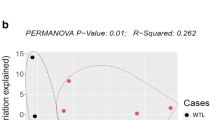Abstract
Studies were conducted to determine the effects of dietary selenium (Se) on the hindgut microbial activity in rats. Selenium was fed asl-selenomethionine (SeMet) at either 0 or 2 ppm Se in the presence or absence of wheat bran (WB, 10%), a known substrate for the enteric microflora. Wheat bran feeding caused the greatest fermentation, measured by the production of short-chain fatty acids (SCFAs) along the entire intestinal tract and feces; however, its effects were suppressed by SeMet in the proximal large bowel, cecum, and colon. Selenium significantly enhanced fermentation in the colon and rectum, but not in the cecum or feces. Selenium was found in association with the bacterial cell fractions of gut contents and feces: 40–46% of the total Se was associated with colonic microbes and 58% in fecal microbes. Increased acetate and reduced butyrate production were driven by the addition of Se regardless of whether WB was fed.
Similar content being viewed by others
References
R. J. Shamberger and D. V. Frost, Possible protective effect of selenium against human cancer,Can. Med. Assoc. J. 100, 682 (1969).
R. J. Shamberger, S. A. Tytko, and C. E. Willis, Antioxidant and cancer. Part VI. Selenium and age-adjusted human cancer mortality,Arch. Environ. Health 31, 231–235 (1976).
W. C. Willet, B. F. Polk, J. S. Morris, M. J. Stampfer, S. Pressel, B. Rosner, J. O. Taylor, K. Schneider, and C. G. Hames, Prediagnostic serum selenium and risk of cancer,Lancet 2, 130–133 (1983).
L. C. Clark, G. F. Combs, Jr., L. Hixson, D. R. Deal, J. Moore, J. S. Rice, M. Dellasega, A. Rogers, and J. Woodaro, Low plasma selenium predicts the prevalence of colorectal adenomatous polyps in a cancer prevention trial,FASEB J. 7, 3–4 A6 (1993).
D. F. Birt, Inhibition by dietary selenium of colon cancer induced in the rat by bis (2-oxopropyl) nitrosamine,Cancer Res. 42, 4455–4459 (1982).
M. Jacobs, Selenium inhibition of 1,2-dimethylhydrazine-induced colon carcinogenesis,Cancer Res. 43, 1646–1649 (1983).
L. C. Clark, G. F. Combs, Jr., and B. W. Turnbull, The nutritional prevention of cancer with selenium 1983–1993: a randomized clinical trial,FASEB J. 10, A550 (1996).
E. Canzi, A. Tinarelli, F. Brighenti, G. Testolin, T. Brusa, E. Del Puppo, and A. Ferrari, Influence of long-term feeding of different purified dietary fibers on cecal microflora composition and its metabolizing activity on bile acids,Nutr. Res. 14, 1549–1559 (1994).
P. J. Van Soest, Some physical characteristics of dietary fibres and their influence on the microbial ecology of the human colon,Proc. Nutr. Soc. 43, 26–69 (1984).
D. Schottenfeld and J. F. Hass, Epidemiology of colon cancer, inGastrointestinal Tract Cancer, M. Lipin and R. A. Food, eds., Plenum, New York, pp. 207–240 (1978).
A. McIntyre, G. P. Young, T. Taranto, P. R. Gibson, and P. B. Ward, Different fibers have different regional effects on luminal contents of rat colon,Gastroenterology 101, 1274–1281 (1991).
A. Martinez and D. C. Church, Effect of various mineral elements onin vitro rumen cellulose digestion,J. Anim. Sci. 31, 982–990 (1970).
A. B. Serra, K. Nakamura, T. Matsui, T. Harumoto, and T. Fujihara, Inorganic selenium for sheep: II. Its influence on rumen bacterial yield, volatile fatty acid production and total tract digestion of timothy hay,Asian-Australasian J. Anim. Sci. 7, 91–96 (1994).
J. Kim, P. J. Van Soest, and G. F. Combs, Jr., Studies on the effects of selenium on rumen microbial fermentationin vitro, Biol. Trace Elem. Res., This issue, pp. 203–213.
G. A. Weaver, J. A. Krause, T. L. Miller, and M. J. Wolin, Constancy of glucose and starch fermentations by two different human faecal microbial communities,Gut 30, 19–25 (1989).
N. L. Whitehouse, V. M. Olson, C. G. Schwab, W. R. Chesbro, K. D. Cummingham, and T. Lykos, Improved techniques for dissociating particle-associated mixed rumen microorganism from rumen digesta solids,J. Anim. Sci. 72, 1335–1343 (1994).
O. E. Olson, Fluorometric analysis of selenium in plants,J. Assoc. Ana. Chem. 52, 627–634 (1969).
G. T. MacFarlane, G. R. Gibson, E. Beatty, and J. H. Cummings, Estimation of shortchain fatty production from protein by human intestinal bacteria on branched-chain fatty acid measurements,FEMS Microbiol. Ecol. 101, 81–88 (1992).
Y. Marson, R. J. Illman, J. M. Clarke, R. P. Trimble, and D. L. Topping, Plasma lipids and large bowel volatile fatty acids in pigs fed on white rice, brown rice and rice bran,Br. J. Nutr. 70, 503–513 (1993).
M. J. Axley and T. C. Stadtman, Selenium metabolism and selenium-dependent enzymes in microorganisms,Ann. Rev. Nutr. 9, 127–137 (1989).
A. A. Salyers, Energy sources of major intestinal fermentative anaerobes,A. J. C. N. 32, 158–163 (1979).
Author information
Authors and Affiliations
Rights and permissions
About this article
Cite this article
Kim, J., Combs, G.F. Effects of selenium on colonic fermentation in the rat. Biol Trace Elem Res 56, 215–224 (1997). https://doi.org/10.1007/BF02785394
Received:
Accepted:
Issue Date:
DOI: https://doi.org/10.1007/BF02785394




